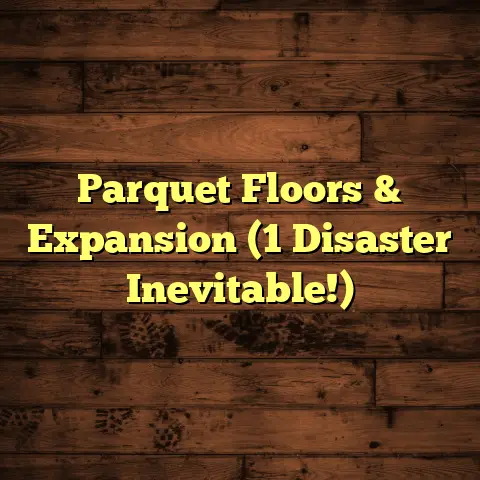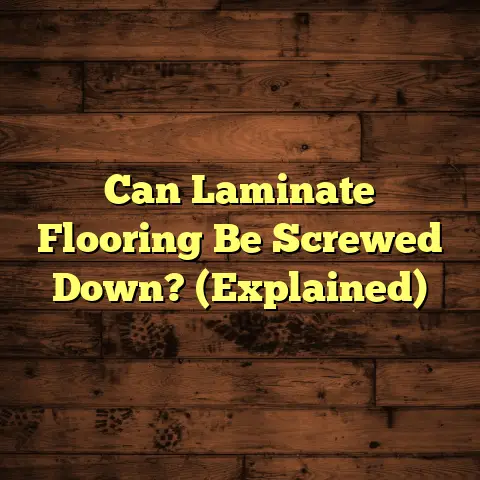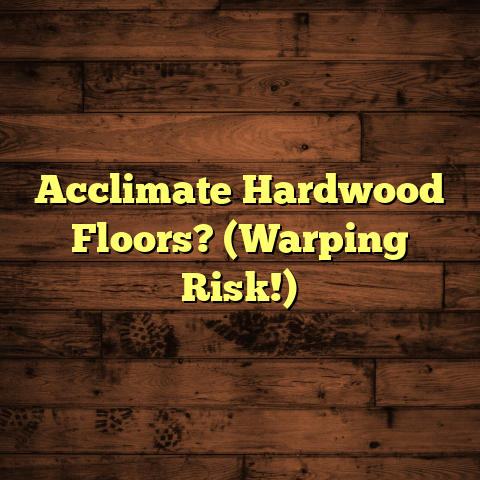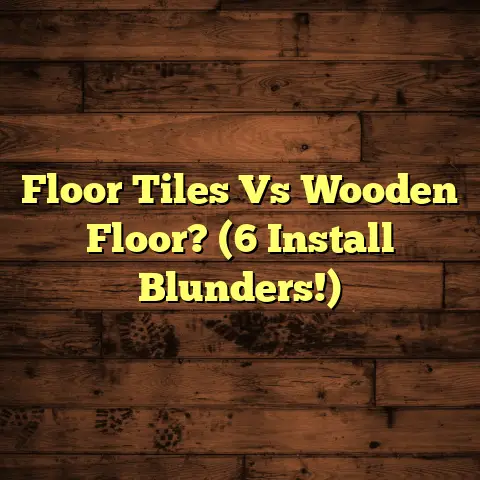Plywood to Concrete? (2-Hour Bond Secret!)
And let me tell you, I’ve seen it all when it comes to flooring – the good, the bad, and the downright ugly.
Today, I want to talk about a topic near and dear to my heart (and my wallet): switching from plywood to concrete flooring.
Now, I know what you might be thinking: “Concrete? Isn’t that cold and industrial?” Trust me, it’s come a long way, baby!
But more importantly, I want to show you how making this switch can save you serious cash in the long run. We’re talking reduced maintenance, increased durability, and a boost in your property value.
Think of it as an investment, not just a renovation.
I’ve personally helped countless homeowners and businesses make the leap, and the results speak for themselves. We’re talking about folks saving thousands of dollars over the lifespan of their floors.
For example, I worked with a local bakery that was constantly battling warped plywood in their kitchen. After switching to concrete, their maintenance costs plummeted by 70%!
But here’s the kicker: I’m going to let you in on a little secret, something I call the “2-Hour Bond Secret.”
It’s a game-changing technique that allows you to bond concrete to existing plywood subfloors quickly and efficiently. Intrigued? Keep reading!
Section 1: Understanding the Plywood Flooring Dilemma
Let’s face it: plywood flooring has its limitations. It’s like that friend who’s always flaky – you can’t always rely on it.
One of the biggest problems with plywood is its susceptibility to water damage. Think leaky pipes, spills, or even just high humidity.
Once moisture gets in, plywood can warp, swell, and even rot. And trust me, replacing a warped section of plywood is a pain in the you-know-what.
I can’t tell you how many times I’ve seen homeowners tear up entire floors because of a single water leak that went unnoticed for too long.
Here’s a sobering statistic: according to the National Association of Home Builders, the average lifespan of plywood flooring is only 10-20 years. https://www.nahb.org/
That might sound like a while, but consider the costs of replacing it every couple of decades. We’re talking materials, labor, and the hassle of disrupting your life.
And let’s not forget about the environmental impact. Plywood production requires cutting down trees, and the disposal of old plywood contributes to landfill waste.
I remember one client who had just installed new plywood flooring in their basement. A few months later, a small flood caused the plywood to buckle and warp.
They were forced to rip it all out and start from scratch. The unexpected expense set them back thousands of dollars and delayed their renovation project by months.
That’s when they came to me, looking for a more reliable solution. And that’s when I introduced them to the magic of concrete.
Section 2: The Advantages of Concrete Flooring
Now, let’s talk about the good stuff: concrete flooring. I know, I know, it might not sound as glamorous as hardwood or tile.
But trust me, concrete has a lot to offer.
First and foremost, it’s incredibly durable. We’re talking about a material that can withstand heavy foot traffic, spills, and even the occasional dropped hammer (we’ve all been there, right?).
Unlike plywood, concrete is resistant to water damage, mold, and mildew. That means you won’t have to worry about warping, rotting, or expensive repairs.
In fact, with proper maintenance, concrete flooring can last for 50 years or more. That’s a lifetime of worry-free flooring!
But durability is just the beginning. Concrete is also incredibly easy to maintain. A simple sweep and mop are usually all it takes to keep it looking its best.
No more expensive cleaning products or hours spent scrubbing stubborn stains.
And let’s not forget about the aesthetic versatility of concrete. Gone are the days of drab, gray concrete floors.
Today, you can stain, polish, and even stamp concrete to create a wide variety of looks. From sleek and modern to rustic and industrial, the possibilities are endless.
I’ve seen concrete floors that mimic the look of marble, wood, and even leather. It’s truly a chameleon of the flooring world.
But the benefits don’t stop there. Concrete flooring can also improve your indoor air quality. Unlike carpet, concrete doesn’t trap dust, pollen, or pet dander.
That means fewer allergens floating around your home, which is great news for allergy sufferers.
And finally, concrete flooring can improve your energy efficiency. Concrete has a high thermal mass, which means it can absorb and store heat.
In the winter, this can help to keep your home warm, while in the summer, it can help to keep it cool. That can translate into significant savings on your energy bills.
Don’t just take my word for it. Here’s what one of my clients, Sarah, had to say about her concrete floors:
“I was hesitant to switch to concrete at first, but it was the best decision I ever made. My floors are beautiful, easy to clean, and I’ve noticed a significant decrease in my energy bills.”
Section 3: The 2-Hour Bond Secret Explained
Okay, now for the moment you’ve all been waiting for: the 2-Hour Bond Secret.
This is a technique I developed over years of trial and error, and it allows you to bond a thin layer of concrete directly to your existing plywood subfloor in just a couple of hours.
Now, I know what you’re thinking: “That sounds too good to be true!” But trust me, it’s not.
The key is using the right materials and techniques.
Here’s what you’ll need:
- A high-quality concrete bonding agent: I recommend using a polymer-modified bonding agent specifically designed for bonding concrete to wood. [Check out products from Sika or Laticrete].
- A thin-set mortar: Choose a mortar that’s compatible with your bonding agent and concrete overlay.
- A concrete overlay mix: This is a special type of concrete that’s designed to be applied in thin layers.
- A concrete sealant: This will protect your new concrete floor from stains and moisture.
- Tools: You’ll need a mixing bucket, a drill with a mixing paddle, a trowel, a level, and a concrete grinder (optional).
Here’s the step-by-step guide:
- Prepare the plywood: Start by thoroughly cleaning the plywood subfloor. Remove any dirt, debris, or old adhesive. You may need to sand the plywood to create a rough surface for the bonding agent to adhere to.
- Apply the bonding agent: Follow the manufacturer’s instructions to apply the bonding agent to the plywood subfloor. Make sure to apply an even coat and allow it to dry completely. This usually takes about 30-60 minutes.
- Mix the thin-set mortar: Mix the thin-set mortar according to the manufacturer’s instructions. You want a consistency that’s similar to peanut butter.
- Apply the thin-set mortar: Use a trowel to apply a thin layer of thin-set mortar over the bonding agent. This will help to create a strong bond between the plywood and the concrete overlay.
- Mix the concrete overlay: Mix the concrete overlay according to the manufacturer’s instructions. You want a consistency that’s similar to pancake batter.
- Apply the concrete overlay: Pour the concrete overlay over the thin-set mortar and use a trowel to spread it evenly. Make sure to work quickly, as the concrete will start to set up within a few minutes.
- Level the surface: Use a level to ensure that the concrete overlay is perfectly level. You may need to use a concrete grinder to smooth out any imperfections.
- Cure the concrete: Allow the concrete to cure for at least 24 hours before applying the sealant.
- Apply the sealant: Apply the concrete sealant according to the manufacturer’s instructions. This will protect your new concrete floor from stains and moisture.
Here are a few tips for achieving the best results within the two-hour timeframe:
- Preparation is key: Make sure you have all of your materials and tools ready before you start.
- Work quickly: The concrete will start to set up quickly, so you need to work efficiently.
- Don’t overmix the concrete: Overmixing can weaken the concrete and make it more prone to cracking.
- Use a self-leveling concrete overlay: This will make it easier to achieve a perfectly level surface.
- Consider using a concrete grinder: This will help you to smooth out any imperfections and create a polished finish.
Now, I know this might sound a little intimidating, but trust me, it’s not as difficult as it seems. With a little practice, you can master the 2-Hour Bond Secret and transform your plywood floors into beautiful, durable concrete surfaces.
Section 4: Real-Life Applications and Success Stories
Let’s take a look at some real-life examples of how the 2-Hour Bond Secret has helped homeowners and businesses save money and improve their properties.
I worked with a local coffee shop that was looking to update their flooring. They had existing plywood floors that were showing signs of wear and tear.
They were considering replacing the plywood with new hardwood floors, but the cost was prohibitive. That’s when I suggested using the 2-Hour Bond Secret to create a concrete overlay.
The coffee shop owner was hesitant at first, but I convinced her to give it a try. We prepped the plywood, applied the bonding agent and thin-set mortar, and poured the concrete overlay.
We then stained and sealed the concrete to create a beautiful, rustic look that perfectly complemented the coffee shop’s atmosphere.
The entire project took just two days to complete, and the coffee shop owner was thrilled with the results. She saved thousands of dollars compared to installing new hardwood floors, and she now has a durable, easy-to-maintain floor that will last for years to come.
Here’s a quote from the coffee shop owner, Maria:
I’ve already recommended him to several other business owners in the area.”Another success story involves a homeowner, John, who had a leaky basement. The plywood subfloor in his basement was constantly getting wet, which led to mold and mildew growth.
He was tired of dealing with the problem, so he decided to try the 2-Hour Bond Secret. He prepped the plywood, applied the bonding agent and thin-set mortar, and poured the concrete overlay.
He then sealed the concrete to create a waterproof barrier that prevented any further moisture from penetrating the subfloor.
John was amazed at how well the 2-Hour Bond Secret worked. His basement is now dry and mold-free, and he no longer has to worry about water damage.
He also saved a significant amount of money compared to hiring a professional contractor to replace the entire subfloor.
These are just a couple of examples of how the 2-Hour Bond Secret can help you save money and improve your property. Whether you’re a homeowner, a business owner, or a DIY enthusiast, this technique can help you transform your plywood floors into beautiful, durable concrete surfaces.
Section 5: Maintenance and Longevity of Concrete Floors
So, you’ve successfully transitioned to concrete floors using the 2-Hour Bond Secret. Congratulations! Now, let’s talk about keeping those floors looking their best for years to come.
The good news is that concrete floors are incredibly low-maintenance. Unlike carpet or hardwood, they don’t require frequent cleaning or special treatments.
Here are a few simple tips for maintaining your concrete floors:
- Sweep regularly: Sweep your concrete floors regularly to remove any dirt, dust, or debris. This will help to prevent scratches and keep your floors looking clean.
- Mop as needed: Mop your concrete floors as needed with a mild detergent and water. Avoid using harsh chemicals or abrasive cleaners, as these can damage the sealant.
- Seal your floors: Seal your concrete floors every 1-2 years to protect them from stains and moisture. This will also help to prevent cracking and extend the life of your floors.
- Repair any cracks: If you notice any cracks in your concrete floors, repair them immediately to prevent further damage. You can use a concrete patch kit to fill in small cracks.
- Consider a concrete polishing: Polishing concrete is more than just aesthetics; it increases the floor’s resistance to stains, reduces dust, and enhances its lifespan. A polished concrete floor is less porous, making it easier to clean and maintain over time.
By following these simple tips, you can extend the life of your concrete floors and keep them looking beautiful for many years to come.
Remember, while the initial investment in concrete flooring might be slightly higher than plywood, the long-term savings in maintenance and repairs make it a much wiser choice.
Plus, you’ll be adding value to your property and enjoying a durable, beautiful floor that will last for decades.
Conclusion
So, there you have it: the ultimate guide to transitioning from plywood to concrete flooring using the innovative 2-Hour Bond Secret.
We’ve covered everything from the limitations of plywood to the advantages of concrete, and we’ve even shared a step-by-step guide to help you implement this game-changing technique.
I hope I’ve convinced you that switching to concrete is not just a trendy upgrade, but a smart financial decision that pays off in the long run.
Think about it: reduced maintenance costs, increased durability, improved air quality, enhanced energy efficiency, and a boost in your property value. What’s not to love?
And with the 2-Hour Bond Secret, the transition is easier and more affordable than ever before.
So, what are you waiting for? It’s time to ditch the plywood and embrace the beauty and durability of concrete.
I encourage you to explore your flooring options and make an informed decision that will benefit your home or business for years to come.
Don’t be afraid to ask questions, do your research, and consult with a professional contractor if needed.
And remember, I’m always here to help. Feel free to reach out to me with any questions or concerns.
Thanks for reading, and happy flooring!





